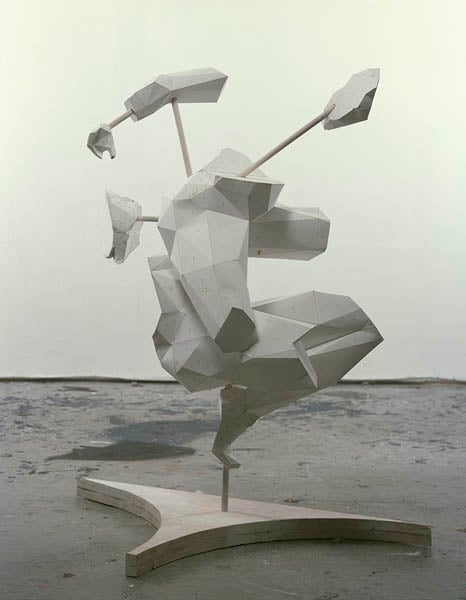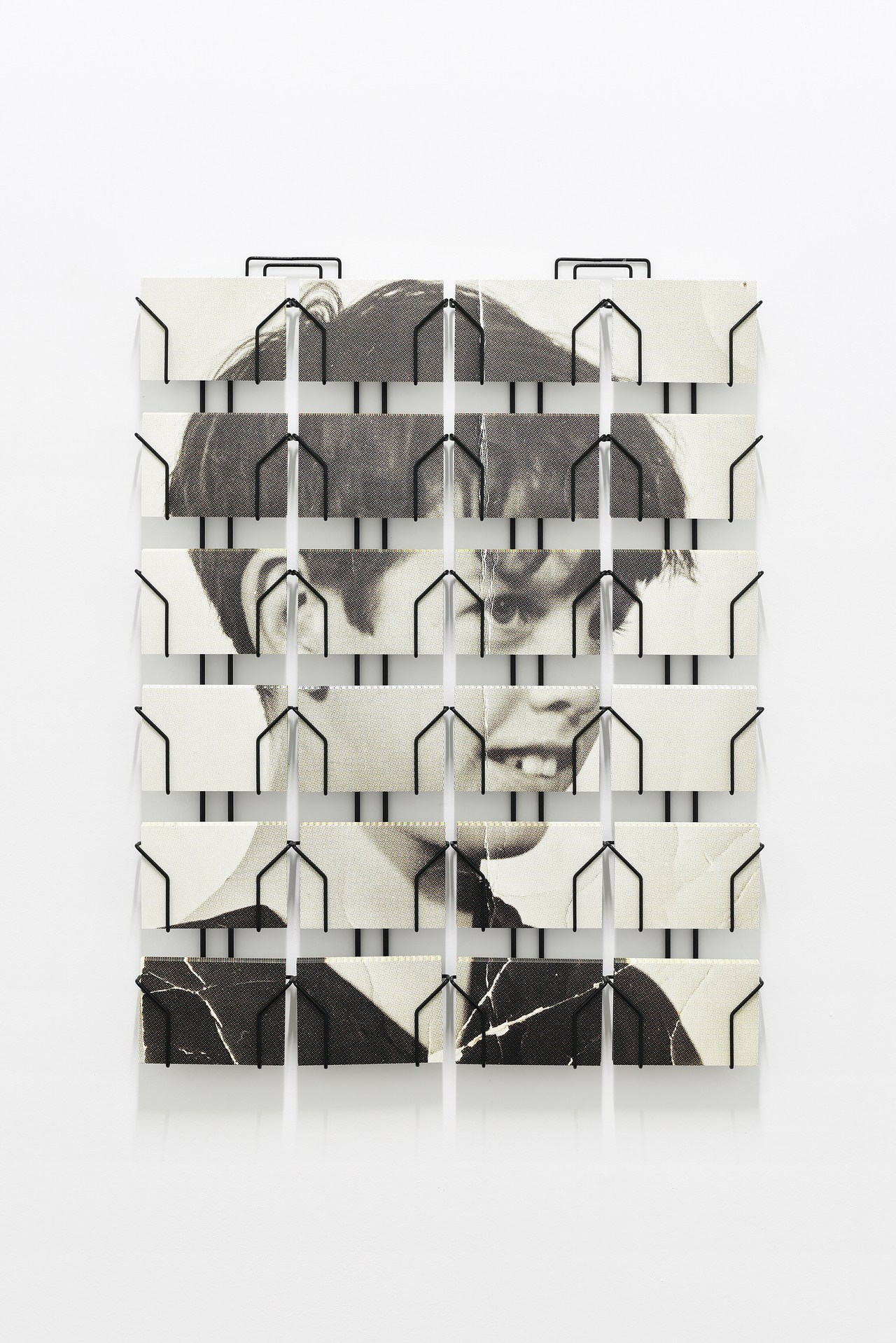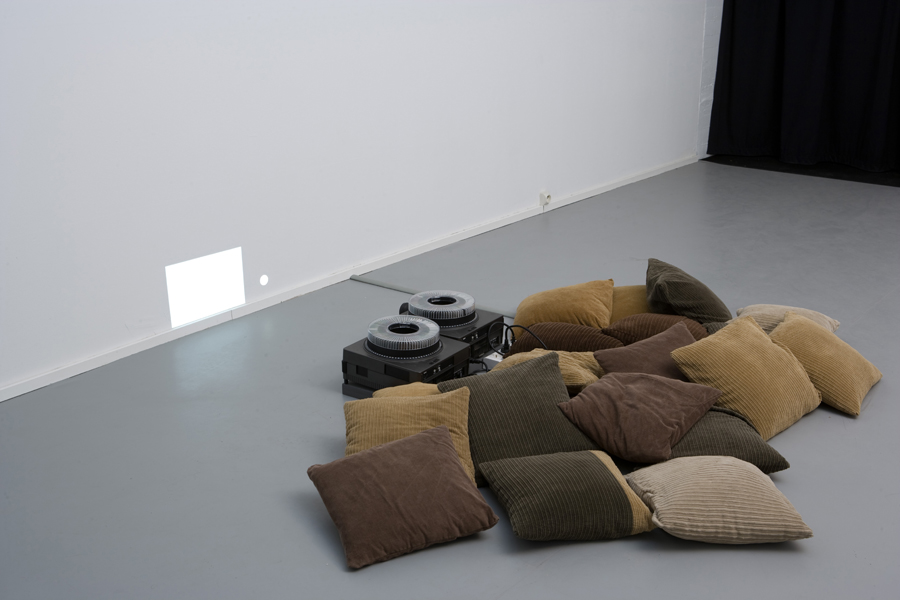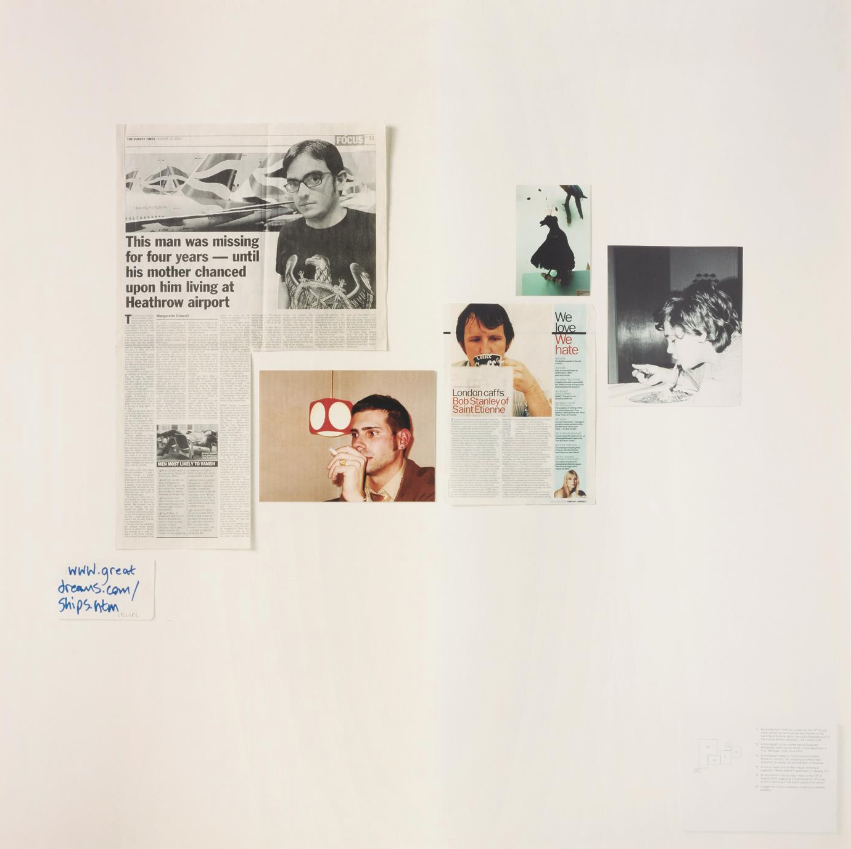
© » KADIST
Matthew Buckingham
Matthew Buckingham presents a narrative directly connected with a highly symbolic site in the United States, the Mount Rushmore Memorial*. He elaborates a historiographic narrative of this place and switches it into the domain of science fiction by proposing a photograph of the Memorial as it should appear in 500 000 years. The effigies of Washington, Jefferson, Lincoln and Roosevelt become unrecognizable.

© » KADIST
Jennifer Bornstein
Collectors’ Favorites is an episode of local cable program from the mid-1990s in which ordinary people were invited to present their personal collections—a concept that in many ways anticipates current reality TV shows and internet videos. When it comes her turn to “perform,” Bornstein displays mundane and disposable—but elaborately archived or framed—consumer objects such as coffee lids, plastic straws, candy wrappers, and product labels. Through the medium of public broadcasting, then, she makes visual the frequently overlooked but massive cultural penetration of advertising, and its proliferation of “throwaway culture” via images.

© » KADIST
Fred Wilson
Fred Wilson’s flag paintings document the 20th century history of African people, indexing the period of liberation from colonialism. As the majority of African flags were created during the 1950s and 60s, they were intended to reflect a so-called ‘modern’ aesthetic and ideology. Many African flags maintain the typical flag tropes such as stripes, stars, birds, and blocks of primary and secondary colors; green to represent the land; blue to symbolize the ocean or sky; and red to recall the violence that occured in the pursuit of liberty.

© » KADIST
Matt Mullican
Drawing & Print (Drawing & Print)
Mullican’s Stick Figure Drawings depict characters reduced to their most basic graphic representation. Glen is a simple silhouette, genderless and inspired by a found photo of a crime scene, in whom we recognize the generic sign of the universal symbol of a self-portrait. Mullican continually projects himself, sometimes physically, into the silhouette that he has created, allowing the artist to pass from one reality to another.
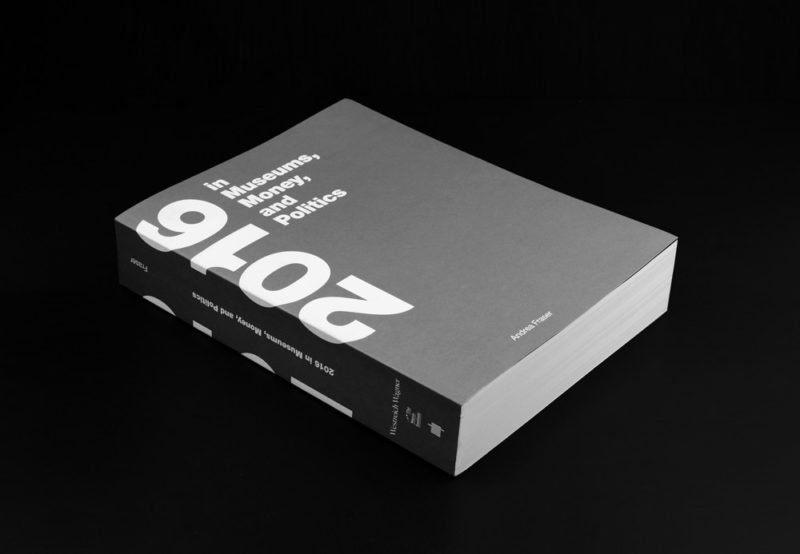
© » KADIST
Andrea Fraser
Drawing & Print (Drawing & Print)
The year 2016 is organized like a telephone book; the data corresponding to the contributions are classified in alphabetical order by the name of the donor. With this database as well as other types of information, the 900-page book presents a material representation of the scale of the cross over between cultural philanthropy and the financing of political campaigns in America. It also provides an unprecedented resource for discovering the political leaning of the museum sector.

© » KADIST
Yang Guangnan
In Action no. 1 Yang Guangnan reflects on the interiority and exteriority of human-technological experience with mechanical gestures that are semi-human and semi-machine. A hanged shirt mounted upon the artist’s machine rhythmically bounces and rotates in a way that suggests a skeletal interior.

© » KADIST
Kelley Walker
The triptych Black Star Press is part of the series ‘The Black Star Press project’ initiated in 2004 by the American artist Kelley Walker. The images in this series are taken from a photo essay on the struggle for civil rights in Alabama, directed by Charles Moore in 1962 (and published by the magazine ‘Life’) which showed the repression of the black population and persistent inequalities in the southern United States. The title “Black Star Press” is taken from the name of the news agency where Charles Moore worked, and it refers to the young black man shot fighting for the rights of his community.

© » KADIST
Yang Guangnan
Itch explores the relationship between technology and daily human experience with a motorized arm that extends from within the gallery’s wall, moving up and down while holding a projector that shows a desperately scratching pair of hands.

© » KADIST
Alexandre da Cunha
His Deck Painting I recalls the simplistic stripes of conceptual artist Daniel Buren, or the minimal lines of twentieth century abstract painting, but is in reality a readymade, fashioned from repurposed fabric of deck chairs. Alexandre da Cunha reinvents found objects in surprising ways that combine the material characteristics of Arte Povera with the concerns and techniques of painting. Da Cunha’s work often features flags—either as a found material per se or as a constructed form—that reflect the artist’s interest in issues of nationality, governmental politics, allegiance, and culture.

© » KADIST
Keith Tyson
The work of Keith Tyson is concerned with an interest in generative systems, and embraces the complexity and interconnectedness of existence. Philosophical problems such as the nature of causality, the roles of probability and design in human experience, and the limits and possibilities of human knowledge, animate much of his work. Language as a coded system, as a representation medium, but also as something that generates a whole variety of realities also plays a central role.

© » KADIST
Martin Creed
This photograph of Martin Creed himself was used as the invitation card for a fundraising auction of works on paper at Christie’s South Kensington in support of Camden Arts Centre’s first year in a refurbished building in 2005. His broad smile, on the verge of laughter, encourages reciprocity on behalf of the onlooker. This could be said to be a typical tactic in Creed’s work as it is so infused with humor and irony.

© » KADIST
Tomoko Yoneda
Yoneda’s Japanese House (2010) series of photographs depicts buildings constructed in Taiwan during the period of Japanese occupation, between 1895 and 1945. Yoneda focuses both on the original Japanese features of the houses and on details that have been altered since the end of the occupation. The yet-to-be acknowledged history of the occupation of Taiwan and other East Asian countries by Japan during World War II is subtly disclosed in these pictures.

© » KADIST
Karla Black
Karla Black is a Scottish artist living in Glasgow . Her work draws from a multiplicity of artistic traditions from expressionist painting, land art performance, to formalism. Her large-scale sculptures incorporate modest everyday substances, along with very traditional art-making materials to create abstract forms.

© » KADIST
Ryan Gander
Epiphany…learnt through hardship is composed of a bronze sculpture depicting the model of the little dancer of Degas, in the pose of a female nude photographed by Edward Weston (Nude, 1936) accompanied by a blue cube. The work refers to the positive occupations of space and the absence of form and structure, to the relationship between the visible and the invisible, to memory, and to the relationship we have to images and to our history. The work refers to childhood, biography and learning to question how meaning is made and how history is remembered and performed.
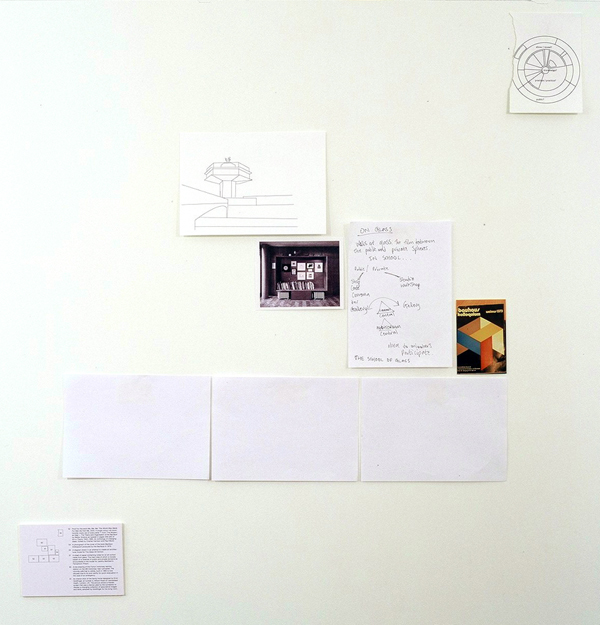
© » KADIST
Ryan Gander
You see without light is a group of photographs around the theme of Bauhaus. This includes a reference to one of Gander’s works which is the Bauhaus manifesto without dots on the letter ‘i’, as well as drawings of his ideal art school.

© » KADIST
Alexandre da Cunha
Glaze (Savana) (2005) is an assemblage of found materials: a car wheel, a tire, and a wooden plinth of the type traditionally used to display sculpture. It directly engages with the readymade, a subject that Alexandre de Cunha takes up throughout his practice, often inflecting it with a tropical, and South American–inspired materiality and painterly style that could potentially come across as a stereotype. Here, da Cunha transforms the component parts into a composition that highlights often-overlooked materials of artistic production and cultural mass-production.

© » KADIST
Rosalind Nashashibi
Rosalind Nashashibi’s paintings incorporate motifs drawn from her day-to-day environment, often reworked with multiple variations. The development of colour palettes in her painting work could be compared to the work in her films where she delicately draws an internal visual language which provides the viewer equal space to her protagonists. Possible readings of her work are left deliberately open, encouraging thought in terms of association rather than the imposition of a narrative structure.
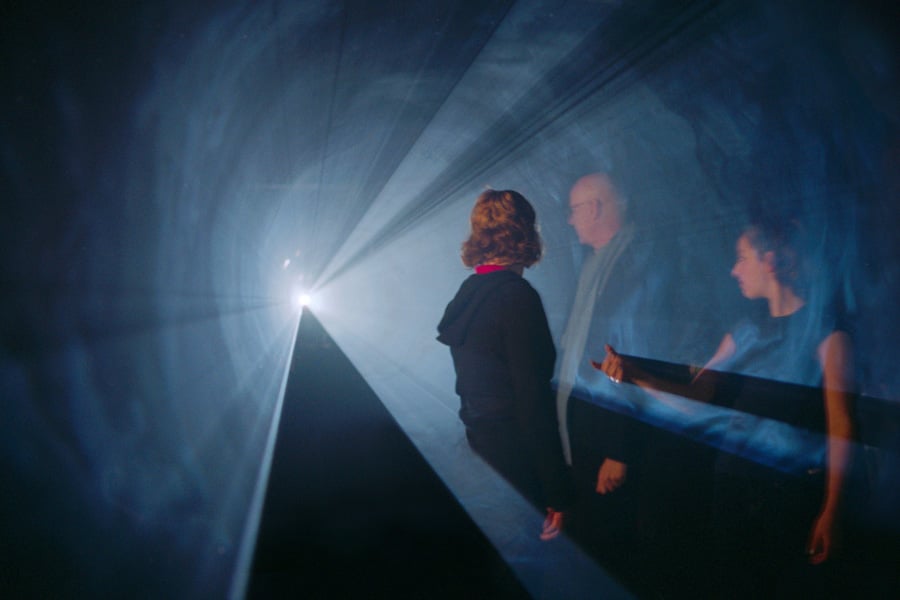
© » KADIST
Anthony McCall
The film Line Describing a Cone was made in 1973 and it was projected for the first time at Fylkingen (Stockholm) on 30 August of the same year. This piece, which was initially screened in independent film contexts, it soon began to be shown at art museums and ended up becoming one of the key works of the artistic movement that opened up the visual arts towards cinema. With a duration of 30 minutes, the film shows the creation of a white curve being projected onto an empty space.

© » KADIST
Charles Avery
Drawing & Print (Drawing & Print)
Charles Avery has been constructing a narrative in his work since 2004. Between fantasy and reality, The Islanders is a very particular universe he has created in which to gather his disparate ideas. His practice primarily involves drawing, sculptures, texts and installations which participate in the epic and dreamlike narrative whole in the course of making.
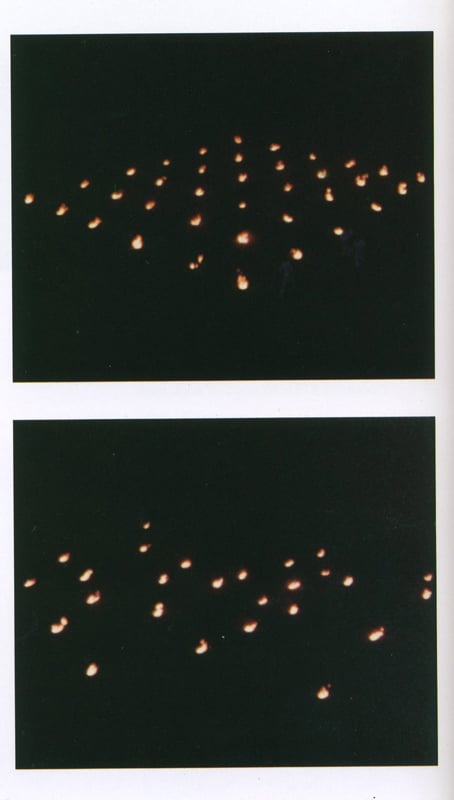
© » KADIST
Anthony McCall
Landscape for fire is a major work by Anthony McCall. The film recounts a performance where characters in white, light up fires in a very orchestrated choreography of lights in a vast flat landscape. The performance is carefully planned – the fires are lit and geometrically aligned in a precise temporal progression.

© » KADIST
Alexandre da Cunha
In Laissez-Faire (Rainbow Flag) da Cunha has turned a beach towel into both a painting and a flag. Where the printed surface of the towel originally served to enliven this commodity, here the pattern—now stretched and re-presented—suddenly refers to abstract painting’s promises of transcendence. And its crisply painted shape pulls the printed colors into the rectangularity of the canvas and, as da Cunha notes, the graphic iconicity of flags.

© » KADIST
Michael Landy
H.2. N. Y Skeleton of the Dump revolves entirely around the performance “Homage to New York” (1960), of the Swiss artist Jean Tinguely (1925-1991), during which the machine built by the artist in the gardens of the Museum of Modern Art (MOMA) had to self-destruct itself in 27 minutes, but, in the end, it had to be finished off by firemenbeing called in after it erupted in flames. Since the discovery of Jean tinguely’s retrospective at the Tate Gallery in London, in 1982, Michael Landy spent two years researching and sketching (charcoal, oil, glue, ink) from his previous research carried out at Museum Tinguely in Basel, and at the MOMA in New York.

© » KADIST
Cerith Wyn Evans
Untitled (Perfect Lovers + 1) by Cerith Wyn Evans takes as its starting point Felix Gonzales-Torres’s seminal work Untitled (Perfect Lovers) , in which two clocks were synchronized and left to run without interference, the implication being that one would stop before the other. Gonzales-Torres’ original work was a personal allusion to his own partner’s increasingly debilitating HIV-related illness, which grapples with the existential tension of coexistence in the face of death. Cerith Wyn Evans’s piece takes the same concept, and adds a third clock, moving from the intimacy of a monogamous relationship to suggest a more expansive, or possibly polyamorous alternative.

© » KADIST
Alexandre da Cunha
The series West (Flag 1), West (Flag 3), and West (Flag 6) continues da Cunha’s ongoing exploration of the form’s various vertical, horizontal, and diagonal stripes. Here, da Cunha overlays thick bars of color (blue, green, and red) on photographs of the ocean at sunset with surfers in floating on the horizon. The solid colors contrast with the fading colors reflected in the sunset, and the tilted orientation suggests a familiar California beach scene.

© » KADIST
Charles Avery
Drawing & Print (Drawing & Print)
Since 2005, Charles Avery has devoted his practice to the perpetual description of a fictional island. Replete with its own population and constantly shifting topography, Avery’s intricately conceived project amounts to an ever-expanding body of drawings, sculptures, installations and texts which evince the island. Exhibited incrementally these heterogeneous elements serve as terms within the unifying structure of the island – as multiple emissions of an imaginary state, and as a meditation on the central themes of philosophy and the problems of art-making.

© » KADIST
Toby Ziegler
The Fifth Quarter might have taken its mysterious inspiration from the eponymous Stephen King story collated into the Nightmares & Dreamscapes collection. Various vanishing points and interior perspectives, like in another painting dated the same year called Continental Breakfast , create a complex matrix in which motifs, shadowy or geometric forms coexist to further confuse the map of this space. A disturbing yet alluring virtual reality composed of a medley of seemingly abstract designs is depicted through digital and painterly means.
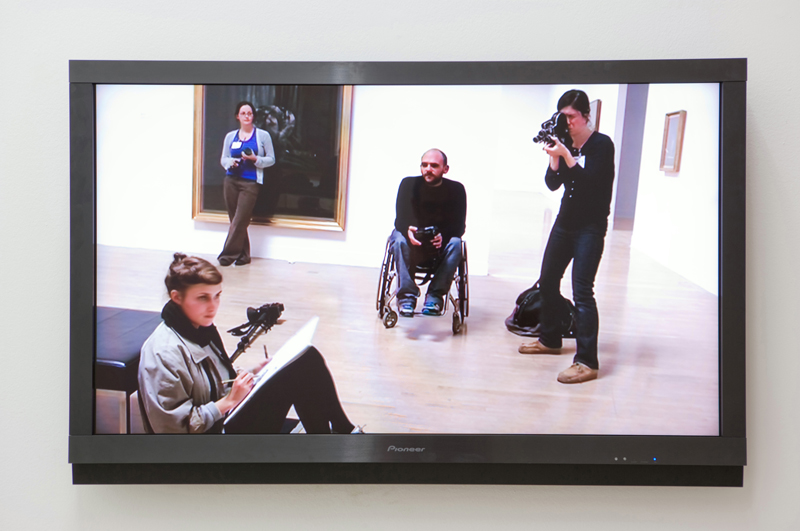
© » KADIST
Ryan Gander
The work consists of a work inside a work. The spectator is presented with a commissioned documentary on a flat-screen Tv on the subject of the production of the making of an artwork that doesn’t exist entitled The magic and the meaning (2008). The imaginary film, The magic and the meaning , is described only within the documentary, which follows parts of the making of the film, extracts from interviews with the writer and film maker Dan Fox and the artist and maker of the work Ryan Gander; as well as showing short slow-motion sections of the film that does not exist.

© » KADIST
Anthony McCall
Drawing & Print (Drawing & Print)
This score is a graphic record of the detailed choreography of one of Anthony McCall’s Landscape for Fire performances. These took place between 1972-74 in the UK at the Museum of Modern Art in Oxford, Colchester School of Art, in Reading and in North Weald as well as in Sweden at Fylkingen Society of Contemporary Music and Arts, Stockholm, and in the USA at the William Patterson University, Wayne, New Jersey. Many of these events were photographed by David Kilburn and Carolee Schneemann, only one in 1972 was filmed.

© » KADIST
Martin Boyce
In the installation Our Love is like the Flowers, the Rain, the Sea and the Hours, Martin Boyce uses common elements from public gardens – trees, benches, trashbins– in a game which describes at once a social space and an abstract dream space. The trees, unique sources of light in the exhibition space, produce their own environment. These sculptures, as if extracted from a set, are enough to suggest an atmosphere, a landscape, or a movie.

© » KADIST
Amalia Pica
Memorial for intersections #2 (2013) is a minimalist, black metallic structure that contains the brightly colored translucent circles, triangles, rectangles, and squares that originally were presented in Pica’s performance work A ? B ? C (2013).
Ryan Gander
- location: Chester, United Kingdom
- year born: 1976
- gender: male
- nationality: British
Alexandre da Cunha
- location: London, United Kingdom
- year born: 1969
- gender: male
- nationality: Brazilian
- home town: Rio de Janeiro, Brazil
Anthony McCall
- location: London, United Kingdom
- year born: 1946
- gender: male
- nationality: British
Martin Creed
- location: Wakefield, United Kingdom
- year born: 1968
- gender: male
- nationality: British
Cerith Wyn Evans
- location: London, United Kingdom
- year born: 1958
- gender: male
- nationality: British
- home town: Llanelli, United Kingdom
Toby Ziegler
- location: London, United Kingdom
- year born: 1972
- gender: male
- nationality: British
Charles Avery
- location: Oban, United Kingdom
- year born: 1973
- gender: male
- nationality: British
Yang Guangnan
- location: New York City, United States
- year born: 1986
- home town: Inner Mongolia, China
Kelley Walker
- location: Columbus, United States
- year born: 1969
- gender: male
- nationality: American
Fred Wilson
- location: Bronx, United States
- year born: 1954
- gender: male
- nationality: American
Andrew Grassie
- location: Edinburgh, United Kingdom
- year born: 1966
- gender: male
- nationality: British
Ximena Garrido Lecca
- location: London, United Kingdom
- year born: 1980
- gender: female
- nationality: Peruvian
- home town: Lima, Peru
Keith Tyson
- location: Ulverston, United Kingdom
- year born: 1969
- gender: male
- nationality: British
Martin Boyce
- location: Hamilton, United Kingdom
- year born: 1967
- gender: male
- nationality: British
Tomoko Yoneda
- location: London, United Kingdom
- year born: 1965
- gender: male
- nationality: Japanese
- home town: Akashi-city, Japan
Rosalind Nashashibi
- location: Croydon, United Kingdom
- year born: 1973
- gender: female
- nationality: British
Chris Ofili
- location: Manchester, United Kingdom
- year born: 1968
- gender: male
- nationality: British
Karla Black
- location: Alexandria, United Kingdom
- year born: 1972
- gender: female
- nationality: British
Michael Landy
- location: London, United Kingdom
- year born: 1963
- gender: male
- nationality: British
Jeremy Deller
- location: London, United Kingdom
- year born: 1966
- gender: male
- nationality: British
Andrea Fraser
- location: Montana, United States
- year born: 1965
- gender: female
- nationality: American
Amalia Pica
- location: London, United Kingdom
- year born: 1978
- gender: female
- nationality: Argentine
- home town: Neuquén, Argentina
Ian Breakwell
- location: Derby, United Kingdom
- year born: 1943
- gender: male
- nationality: British
Jennifer Bornstein
- location: United States
- year born: 1970
- gender: male
- nationality: American
- home town: Seattle, Washington
Matt Mullican
- location: Santa Monica, United States
- year born: 1951
- gender: male
- nationality: American
Hiraki Sawa
- location: London, United Kingdom
- year born: 1977
- gender: male
- nationality: Japanese
- home town: Ishikawa, Japan
Matthew Buckingham
- location: Nevada, United States
- year born: 1963
- gender: male
- nationality: American
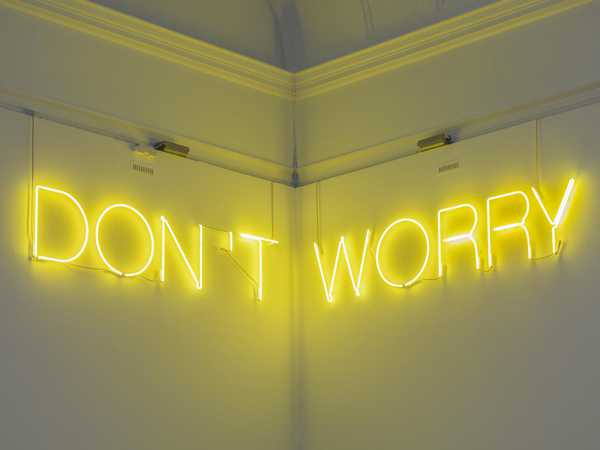
© » TATE EXHIBITIONS
about 3 months ago (01/06/2024)
Martin Creed | The Dick Institute Experience the work of one of this country’s most ingenious, audacious and surprising artists at the Dick Institute ARTIST ROOMS Martin Creed presents highlights from the British artist’s thirty-year career...
-
1970-1979
Anthony McCall
1973The film Line Describing a Cone was made in 1973 and it was projected for the first time at Fylkingen (Stockholm) on 30 August of the same year...
Anthony McCall
Drawing & Print
1974(Drawing & Print) This score is a graphic record of the detailed choreography of one of Anthony McCall’s Landscape for Fire performances...
-
1990-1999
Jennifer Bornstein
1994Collectors’ Favorites is an episode of local cable program from the mid-1990s in which ordinary people were invited to present their personal collections—a concept that in many ways anticipates current reality TV shows and internet videos...
-
2000-2009
Matthew Buckingham
2002Matthew Buckingham presents a narrative directly connected with a highly symbolic site in the United States, the Mount Rushmore Memorial*...
Martin Creed
2003This photograph of Martin Creed himself was used as the invitation card for a fundraising auction of works on paper at Christie’s South Kensington in support of Camden Arts Centre’s first year in a refurbished building in 2005...
Martin Boyce
2003In the installation Our Love is like the Flowers, the Rain, the Sea and the Hours, Martin Boyce uses common elements from public gardens – trees, benches, trashbins– in a game which describes at once a social space and an abstract dream space...
Kelley Walker
2004The triptych Black Star Press is part of the series ‘The Black Star Press project’ initiated in 2004 by the American artist Kelley Walker...
Alexandre da Cunha
2005His Deck Painting I recalls the simplistic stripes of conceptual artist Daniel Buren, or the minimal lines of twentieth century abstract painting, but is in reality a readymade, fashioned from repurposed fabric of deck chairs...
Alexandre da Cunha
2005Glaze (Savana) (2005) is an assemblage of found materials: a car wheel, a tire, and a wooden plinth of the type traditionally used to display sculpture...
Toby Ziegler
2005The Fifth Quarter might have taken its mysterious inspiration from the eponymous Stephen King story collated into the Nightmares & Dreamscapes collection...
Hiraki Sawa
2006Hako (2006) depicts a mysterious and dystopic landscape where the world becomes flat: distance between different spaces, depth of field and three-dimensional perceptions are canceled...
Toby Ziegler
2007Wagon Wheel is a work with a fundamental dynamism that derives both from the rotating movement of the elements suspended on poles and the kicking of the legs of the figure...
Cerith Wyn Evans
2008Untitled (Perfect Lovers + 1) by Cerith Wyn Evans takes as its starting point Felix Gonzales-Torres’s seminal work Untitled (Perfect Lovers) , in which two clocks were synchronized and left to run without interference, the implication being that one would stop before the other...
Ian Breakwell
2008“BC/AD” (Before Cancer, After Diagnoses) is a video of photographs of the artist’s face dating from early childhood to the month before he died, accompanied by the last diary entries he wrote from April 2004 to July 2005 (entitled “50 Reasons for Getting Out of Bed”), from the period from when he lost his voice, thinking he had laryngitis, through the moment he was diagnosed with lung cancer and the subsequent treatment that was ultimately, ineffective...
Fred Wilson
2009Fred Wilson’s flag paintings document the 20th century history of African people, indexing the period of liberation from colonialism...
Andrew Grassie
2009In 2008, Grassie was invited by the Whitechapel Gallery to document the transformation of some of its spaces...
-
2010-2019
Tomoko Yoneda
2010Yoneda’s Japanese House (2010) series of photographs depicts buildings constructed in Taiwan during the period of Japanese occupation, between 1895 and 1945...
Alexandre da Cunha
2010In Laissez-Faire (Rainbow Flag) da Cunha has turned a beach towel into both a painting and a flag...
Yang Guangnan
2011Itch explores the relationship between technology and daily human experience with a motorized arm that extends from within the gallery’s wall, moving up and down while holding a projector that shows a desperately scratching pair of hands....
Charles Avery
Drawing & Print
2011(Drawing & Print) Charles Avery has been constructing a narrative in his work since 2004...
Alexandre da Cunha
2011The series West (Flag 1), West (Flag 3), and West (Flag 6) continues da Cunha’s ongoing exploration of the form’s various vertical, horizontal, and diagonal stripes...
Ryan Gander
2012Epiphany…learnt through hardship is composed of a bronze sculpture depicting the model of the little dancer of Degas, in the pose of a female nude photographed by Edward Weston (Nude, 1936) accompanied by a blue cube...
Charles Avery
Drawing & Print
2012(Drawing & Print) Since 2005, Charles Avery has devoted his practice to the perpetual description of a fictional island...
Jeremy Deller
2012Beyond the White Walls , with a commentary written and spoken by Jeremy Deller, is often wryly amusing...
Amalia Pica
2013Memorial for intersections #2 (2013) is a minimalist, black metallic structure that contains the brightly colored translucent circles, triangles, rectangles, and squares that originally were presented in Pica’s performance work A ? B ? C (2013)...
Ximena Garrido Lecca
2014Destilaciones ( Distillations , 2014) is an installation composed of a group of ceramic pots, presented on the floor and within a steel structure...
Matt Mullican
Drawing & Print
2018(Drawing & Print) Mullican’s Stick Figure Drawings depict characters reduced to their most basic graphic representation...
Rosalind Nashashibi
2019Rosalind Nashashibi’s paintings incorporate motifs drawn from her day-to-day environment, often reworked with multiple variations...
-
2020-2029
Andrea Fraser
Drawing & Print
2020(Drawing & Print) The year 2016 is organized like a telephone book; the data corresponding to the contributions are classified in alphabetical order by the name of the donor...


